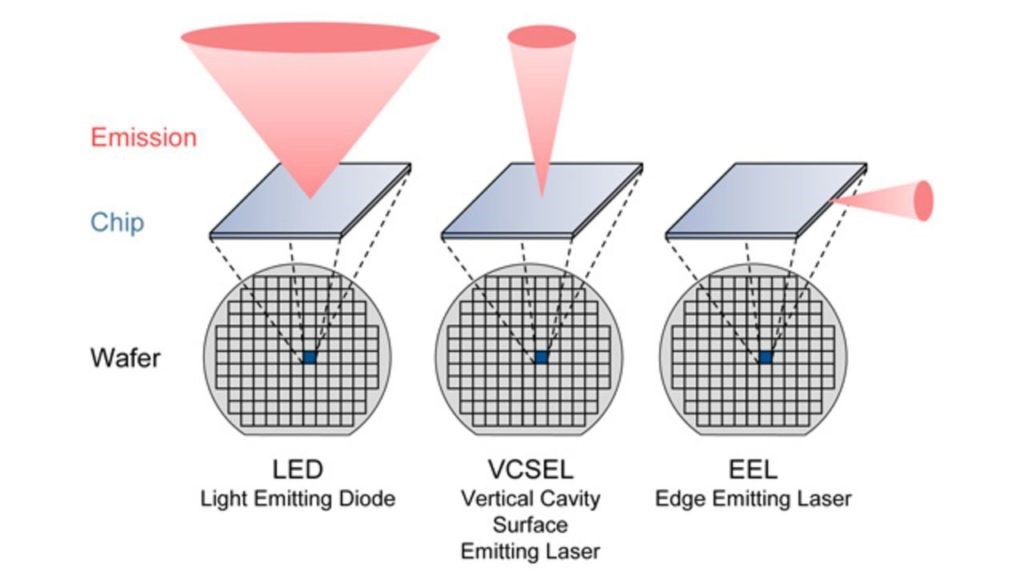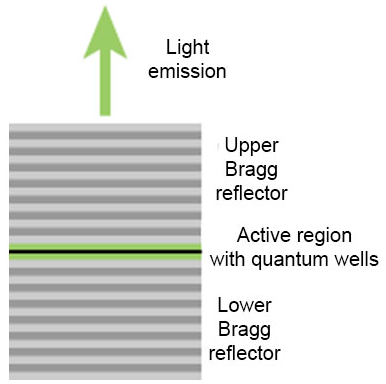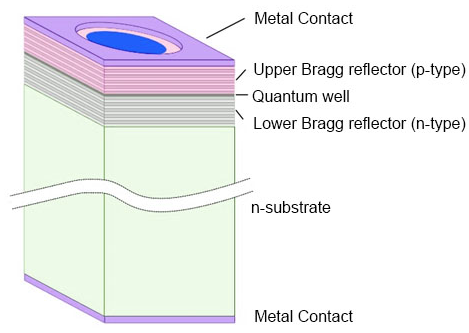Vertical Cavity Surface Emitting Laser(VCSEL)
The Vertical Cavity Surface Emitting Laser (VCSEL or Vertical Cavity Surface Emitter Laser) is a revolutionary device in optical communication and a type of optoelectronic technology with great potential for development.
VCSEL is an abbreviation for vertical cavity surface-emitting laser and actually describes the structure of the device. The laser emits from the top surface of the device and provides a highly compact laser source with a circular emission pattern. This enables easy connection to an optical fiber and practical use in sensing applications. Figure 1 shows the light emission patterns of a light-emitting diode (LED), a VCSEL, and an edge-emitting laser (EEL).

Figure 1. Diagram showing the propagation patterns of LEDs, VCSELs, and EELs. (Image: Instrument Systems).
The outstanding performance of VCSELs has attracted considerable interest and made them a global research focus. Over the past decade, VCSELs have made significant progress in terms of structure, materials, wavelength, and application areas, and many devices have been released on the market.
VCSEL Structure
Figure 2 shows a typical VCSEL structure. This structure is designed with the first main component, the lower Distributed Bragg Reflector (DBR), on top of a semiconductor substrate made of materials such as gallium arsenide (GaAs) or indium phosphide (InP). The DBR consists of layers of semiconductor material with different refractive indices and is designed to strongly reflect light at specific wavelengths.
Above the DBR is the active region, an important component of the VCSEL. This region typically contains ultra-thin layers called quantum wells, which are only a few nanometers thick. The laser light is efficiently produced by the recombination of electrons and holes in the quantum wells.
Around the active region, there are additional layers that typically provide electrical conductivity and act as the upper DBR. Like the lower DBR, the upper DBR contributes to the laser’s high efficiency and precise wavelength control by keeping the emitted light confined within the cavity. This well-designed VCSEL structure provides a reliable and versatile laser source for a wide range of applications, from optical communication to sensing technologies.

Figure 2. Diagram showing the VCSEL structure. (Image: gophotonics)
VCSEL Working Principle
VCSELs operate by injecting an electric current into a semiconductor structure. This current causes electrons and holes to recombine in the active region of the semiconductor, releasing photons in the process. These photons are trapped within the laser cavity created by highly reflective DBRs. Here, resonance and intensity gain occur. As a result, coherent laser light is emitted perpendicular to the semiconductor surface from one of the DBRs. The power of the emitted light can be controlled by adjusting the injected current.

Figure 3. Diagram showing the operating principle of a VCSEL. (Image: gophotonics).
Advantages of VCSEL
- The emitted beam has a circular structure and a low divergence angle. This allows for easy coupling with optical fibers and other optical components while also offering high efficiency.
- It has the ability to perform high-speed modulation and can be used in long-distance, high-speed optical fiber communication systems.
- Thanks to its small active area, it is possible to easily achieve single longitudinal mode and low threshold operation.
- Electro-optical conversion efficiency can exceed 50%, which means the device has a longer lifespan.
- It is easy to create a two-dimensional array. This can be applied to parallel optical logic processing systems, enabling high-speed and high-capacity data processing, and can be used in high-power devices.
- It is easy to create a two-dimensional array. This can be applied to parallel optical logic processing systems, enabling high-speed and high-capacity data processing, and can be used in high-power devices.
- It can be used in laminated optical integrated circuits combined with micro-mechanical technology.
VCSEL Application Areas
Optical Communication
VCSEL technology is used in the communications industry as a light source for optical fiber communications. The unique design of VCSELs enables efficient coupling of light into optical fibers, providing high-speed data transmission. Compared to traditional communications using metal cables, optical fiber communications can transmit data over longer distances and in larger volumes. The growth of data centers, the increase in database communications, fiber connections to homes, and the widespread adoption of cloud-based technology have led to a rapid increase in data communication volume. VCSELs are among the most suitable options for optical communication due to their compact size, economical cost, high modulation bandwidth, and low power consumption.

Figure 4. Visual representation of VCSEL application area
Sensors
VCSELs are used in many different types of sensors, such as proximity sensing, distance measurement, light sensing, and biomedical sensing. Compared to traditional sensors, they offer many advantages, such as lower power consumption, higher sensitivity, and smaller size.
A VCSEL sensor with an integrated photodiode can emit light and simultaneously detect the reflected light using a large “active region” (the area where light is absorbed). When arranged in VCSEL arrays, the sensors can be used for biomedical sensor applications. These applications include reading blood oxygen levels and measuring brain electrical currents using magnetoencephalography (MEG), a non-invasive method.
Small Consumer Electronics
Modern smartphones use VCSELs for many functions. Face recognition and 3D sensing in smartphones are made possible by a VCSEL light emitter, dot projector, and proximity sensor. As consumers demand longer battery life and smaller sizes from their smart devices, VCSELs play a key role in meeting these requirements with their low power requirements, high optical output, compact size, and very narrow spectral width.
VCSELs are also widely used in computer peripherals such as optical mice, printers, and scanners. The coherent light emission of VCSELs enables precise tracking; their ability to emit light at specific wavelengths allows for clear text and detailed images to be printed; and they also provide accurate and consistent scanning results.

Figure 5. Visual representation of VCSEL application area
Vehicles
In vehicle tracking applications, VCSELs offer many advantages over LEDs, including a narrow output spectrum, low spectral temperature coefficient, and high modulation capacity. Another advantage of VCSELs in automotive applications is their immunity to sunlight. LED-based tracking devices are sensitive to interference from ambient light such as sunlight, street lights, and headlights because they operate across a wide spectrum. VCSELs, on the other hand, operate across a narrower spectrum, enabling them to achieve a better signal-to-noise ratio, higher sensitivity, and greater resistance to environmental conditions during driving when used with a narrower spectral filter.
VCSELs are also used in LiDAR (Light Detection and Ranging) systems for autonomous vehicles and environmental mapping. VCSELs enable autonomous vehicles to navigate complex environments safely and efficiently by offering higher resolution, improved range, and faster response times.

CUNAM Projects
As the CUNAM team, we are making significant contributions to our innovative work in the field of laser technologies by focusing on VCSEL technology. In particular, the rapid growth of the market share of VCSEL-type lasers, along with their increasing application areas and new technological potential, has increased the strategic importance of our work in this field. In this context, in collaboration with Bilkent University, the final report of the TUBITAK-1003 Priority Areas project titled “VCSEL-Based High-Power Semiconductor Lasers” with the project number 116F365 was submitted in 2021.
https://www.dentonvacuum.com/vertical-cavity-surface-emitting-lasers-vcsels-and-their-applications/
https://www.gophotonics.com/community/what-are-vertical-cavity-surface-emitting-lasers-or-vcsels
https://www.fiberoptics4sale.com/blogs/archive-posts/95051078-vcsel-laser-the-advantages-of-vcsel